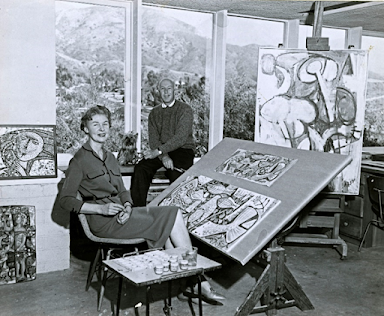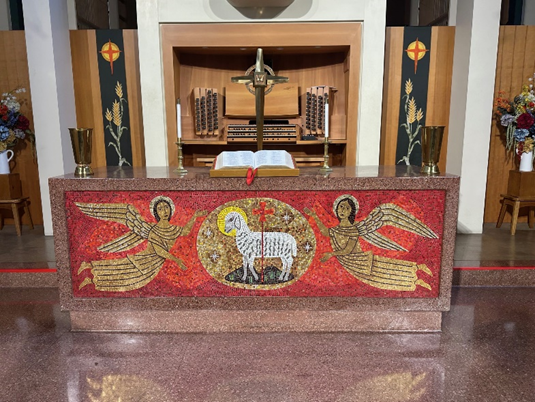Claremont’s Masters: Artists of the Claremont Community #1: Jean Goodwin Ames
Cooper Crane
Archivist, Researcher
Claremont Heritage
July 2024
Claremont’s Masters: Artists of the Claremont Community
#1: Jean Goodwin Ames
Claremont for its size, has had a disproportionately profound impact on the arts in California. The Claremont Colleges have long been centers for art education, and the city of Claremont has prided itself on its aesthetic values. But it has also produced artists whose reach has extended far beyond the city limits. Claremont’s Masters is a new series from the archives team at Claremont Heritage, focused on studying the many artists who have lived in Claremont and who have transformed its environment. Many of these artists’ work continue to feature prominently in the daily lives of those living in Claremont, and the rest of California, and we hope to bring attention to their work.
Undoubtedly, many of the artists who have lived and worked in Claremont can be described as Masters, including Jean Goodwin Ames. Ames was an artist who was practically involved in almost every artform imaginable. She is primarily known for her work in mosaics, but she also worked in tapestries, ceramics, drawings and sketches, paintings, and enameling. Ames was an award-winning artist, and prestigious teacher whose career stretched over 30 years. Her art can be found across Los Angeles and Orange County. Her students included figures such as Karl Benjamin and Betty Davenport Ford, and her ideas continue to shape art and design. In 1939 she was described by LA Times Art critic Arthur Millier as the most important women painter in Southern California, and in 1958 she was named the LA Times woman of the year in art. This month we look at her life in the arts and where she left her mark in Claremont.
Biographical Information
Jean Goodwin Ames, née Jean Goodwin was born in Santa Ana, California in 1903. Ames attended several schools, including Pomona College, Chouinard, and the Chicago Art Institute, where she completed a three-year program in arts, and UCLA, where she received a Bachelor of Education before working as a high school teacher for several years. Ames then attended USC where she received her M.F.A. to pursue higher level teaching positions. Ames’s senior project at USC was a mosaic entitled Youth and Science which can be seen at USC’s Zumberge Hall. It was at USC where Ames met her future husband, Arthur Ames, while attending classes. After graduating from USC in 1937, Ames created a mural, Three Woman Gathering at the Sea Shore for Newport Harbor Union Highschool, created for the Federal Arts Program. She subsequently joined the WPA (Works Progress Administration) in 1940 where she worked as part of the murals division with Arthur, beginning a working relationship with Millard Sheets, who would employ the two to create mosaics for his numerous art and architectural projects. A year later, Arthur and Jean were married.
The importance of the Federal Arts Program and the WPA for their careers cannot be understated. In an interview with the Smithsonian, Ames reflected on her work with the WPA and how it was important to her development as an artist. Explaining how the requirements of painting public murals required different approaches and art techniques, Ames stated, “It gave us an opportunity to explore certain techniques that we might not have otherwise, such as fresco, mosaic, tempera painting. That experience was very valuable to me.” More than this, the WPA provided security and opportunities for her and other artists during the depression when little other work could be found. Ames emphasized this, saying that: “There was no doubt that it effected our whole generation: It gave us an opportunity to be artists.”
It was through the working relationship with Millard Sheets that Jean and Arthur found many of the positions where they solidified their careers and were exposed to the variety of mediums they worked with. While working at the WPA, Sheets had introduced Jean to tapestries. “We became acquainted with this particular steelier in Aubusson, and correspond[ed] with them, and having seen the way that Milard had designed them… that I made some first for my designs and then Arthur designed the big ones for the Claremont Theater.”
Also beginning in 1940, Ames began her teaching career at Scripps College and Claremont Graduate School. Millard Sheets had founded Scripps College’s art department in 1935 and had hired Ames to teach painting and drawing. In 1941, Jean and Arthur Ames were introduced to enameling after viewing an exhibition by German artist Karl Drerup. They became fascinated by the technique and quickly set up a kiln for copper enameling in Scripp’s ceramics department. By 1947 they had begun a studio for enamelware: this passion manifested in the form of countless community projects, from enamel panels for the doors at the Temple Emanual in Beverly Hills, to enamel plates featuring fantastical depictions of mythical creatures inspired by Scandinavian design. The two worked frequently with Richard Peterson, who introduced Jean and Arthur to American suppliers of enamel, enabling their exploration of the medium. In the latter half of the 50s, Ames had also become involved with stained glass, and began more frequently working with community churches, including Claremont’s United Church of Christ.
Jean and Arthur Ames (Jean and Arthur Ames Collection, Claremont Heritage)
Ames eventually became the head of Claremont Graduate University’s M.F.A program, a position she held until her retirement in 1969. Upon retirement, Jean Ames was conferred with the honor of Professor Emerita, which she held until her death in 1986. Her students while teaching at Scripps and CGU included such distinguished artists as Karl Benjamin, Betty Davenport Ford, Paul Darrow, Jack Zajac, and Douglas McClelland. Of her instruction, Paul Darrow recalled, “Here we were—McClellan, Zajac and myself—big strapping guys back from the War. We were cocky, but in her class we were cowed. She gave elaborate color and design problems in which she taught us the meaning of weight, distribution, balance and negative space. Her critiques influenced me immensely.”
Jean and Arthur Ames in their home studio (Jean and Arthur Ames Collection, Claremont Heritage)
Jean Ames’s Art in Claremont and the Pomona Valley
Jean and Arthur Ames frequently worked together as a team, and many of the pieces they created they created as a couple, especially their murals and enamels. We have chosen to include these collaborative works in discussing Jean’s art in the community. Many of their murals and other pieces can still be found in Claremont and the greater Pomona Valley. Within Claremont, there are several examples of their art as a couple that we list here.
• California Bank and Trust, 102 Yale Avenue, Claremont CA
o Claremont’s California Bank and Trust, located at 102 Yale Avenue, has been open for nearly sixty years. Opening in 1966, the bank is one of more than 80 branches, but Claremont’s own branch is especially unique for the mural that adorns the back wall of the teller counter. This mural, another mural done by Jean and Arthur Ames, depicts various scenes from the history of Claremont. From left to right, the mural shows Claremont’s citrus orchards, the Claremont Colleges and their art and theater departments especially, as well as the founding dates of each of the six (now seven, including KGI in 1997) Claremont Colleges: Pomona, Claremont Graduate University, Scripps, Claremont McKenna (originally opened as Claremont Men’s,) Harvey Mudd College, and Pitzer College. Continuing, it also depicts a scene from the Rancho Santa Ana Botanical Gardens, now known as the California Botanical Gardens, just North of the Claremont Colleges and on Route 66, with the Padua Hills Theater visible in the background. Finally, dancers from the Padua Hills Theater of the Mexican Players are painted. The mural highlights small slices of the different institutions, cultures, and facets of life that formed the Claremont Community.
(Image courtesy of California Bank and Trust, Claremont and branch manager Joshua Merry)
• Garrison Theater, 1030 Columbia Avenue, Claremont, CA
o When entering the Garrison Theater at Scripps College, patrons will first pass a mural on the outside of the building depicting scenes from Shakespear, including Antony and Cleopatra, Romeo and Juliet, and King Lear. But upon entering the lobby, there are three large tapestries. The tapestry triptych, Dance of Destiny was commissioned and designed by Jean and Arthur Ames and created at the Aubusson Steelier. The Garrison Theater was originally built on behalf of the entire Claremont Colleges Consortium in 1962, but in 1999 Scripps College had assumed ownership. Renovations in 2002 brought the theater more in-line with the modern design of the theater today but left the tapestries and lobby untouched.
• Pomona Mall, 409 West Second Street, Pomona, CA
o The Pomona Mall, today the Pomona Arts Colony was originally planned as part of downtown developments in the early 60s. Opening in 1962, the Pomona Mall was designed by Millard Sheets as one of the first pedestrian-oriented malls in the country and was intended to jumpstart urban renewal within Downtown Pomona. Contributing to the mall were Jean and Arthur Ames, who designed several mosaics as well as a fountain, Pomona, Roman Goddess of Fruit Trees by Jean and Arthur Ames. The fountain was restored in 2019 through a combined effort by the City of Pomona, and local donors along with several others designed by Edward Svenson, Sheets, and Albert Stewart. Betty Davenport Ford a student of Jean Ames also contributed to mosaic work along the promenade.
• Claremont United Church of Christ, 233 Harrison Avenue, Claremont, CA
(Photograph of the Lamb of God altar at the Claremont United Church of Christ, 2024, Cooper Crane. Special Thanks to Jasmine Tomita and the Claremont United Church of Christ for permissions.)
o Jean and Arthur designed the altar mosaic for the United Church of Christ, entitled Lamb of God for Millard Sheets Studios who collaborated with architect Theodore Criley to design the new church, in 1955. The mosaic depicts a scene from John 1:29, where John the Baptist sees Jesus and exclaims “Behold, the Lamb of God who takes away the sin of the world.” By the late 1950s, Jean and Arthur had become heavily involved with art for churches across California. The mosaic in Claremont’s United Church of Christ is an excellent example of some of the artwork they produced for churches in the local community. The mosaic, constructed of thousands of individual pieces of glass tile of various colors is shown here in detail to demonstrate the use of color, and texture, such as the raised bumps on individual tiles that help to cause the mosaic to shimmer under light.
Jean Ames’s Art in Collections
Claremont Heritage holds a number of materials from Jean Ames, including several of her paintings and sketches. In her sketches and drawings, Jean had a proclivity to also write poems that corresponded with the sketch. Claremont Heritage also holds a number of their ceramic features, which demonstrate their involvement with enameling. Here is a sample of some of these sketches and earthenware.
Ames’s fantastical sketches draw upon biblical and mythological inspiration. Spirituality was a self-described important aspect of Jean Ames’s life and influenced practically all of her work. Note the poems in the bottom left of these sketches and their meanings. (Scans of sketches from the Jean and Arthur Ames Collection, Claremont Heritage)
(Photographs of materials from the Jean and Arthur Ames Ceramics Collection)
Conclusion
Jean Ames was an accomplished artist, but she was also a pillar of the community. Her career as a teacher influences many who would themselves go on to become Claremont Masters. She played a pivotal role in the development of the Scripps Art Department, as well as the M.F.A. program at Claremont Graduate University. Her art continues to play part in the backdrop of the lives of many Southern Californians, and for those living in Claremont. We have chosen to begin our art series on Claremont’s art community with Jean Ames for the entanglement she has had with the community and because of her devotion to art as a form of community engagement. These are values that we feel best reflect those of Claremont, and of Claremont Heritage itself, values that we should all hope to strive for. Claremont Heritage works to preserve the art of artists like Ames and her students and their memory. We are dependent on donations from the community for that work. Like Ames and her Art, our preservation is a community effort.
Acknowledgements
Claremont Heritage thanks the community for helping to make projects like these possible. We thank California Bank and Trust for permission to take photos of their Ames mural in their Claremont Branch and branch manager Joshua Merry for the photography by him and his team. We thank the Claremont United Church of Christ for permissions for photographs of their altar mosaic. We thank the Claremont United Church of Christ, Jasmine Tomita, and Church historian Ann Sonner for permission to take photos of their church altar, and for helping our research.
We preserve the history of Claremont with the help of contributions from members like you. Consider joining as a member of Claremont Heritage or making a donation today by visiting: Claremont Heritage - Keeping Claremont's History Alive and joining in Claremont’s history.
About the author:
My name is Cooper Crane. I am an archivist and researcher with Claremont Heritage. I currently study history and anthropology with an emphasis on areas including material culture, colonialism, and environmental history. I was born in Anaheim and have lived my whole life in Corona, California, a city with a similar shared history to Claremont. I have degrees in history, anthropology and political science from Norco College California, and a bachelor’s degree from Pomona College in Anthropology, with a minor in history, and am a certified California Climate Steward through the University of California Department of Natural and Agricultural Resources. I write to explore history through the material objects of history, and by exploring the elements of history that are unwritten. My current work at Claremont Heritage includes the curation of artifacts on display at the Garner House and the Claremont Packing House, the creation of artifact descriptions for our archives and contributing to A History of Claremont in 100 Objects.
Citations
Arenson, Adam, et al. Millard Sheets: A Legacy of Art and Architecture. Los Angeles: Los Angeles Conservancy, Mar. 18, 2012.
Claremont Courier. “Spirituality vital to Jean Goodwin Ames creative process” Claremont Courier. Apr. 11, 2022.
Hoag, Betty. “Interview with Jean and Arthur Ames.” Jun. 9, 1965. Held at: Smithsonian Archives of American Art.
Los Angeles Conservancy. “Pomona Mall.” Historic Places in LA. Accessed July 2024.
Márquez, Liset. “Four historic fountains in downtown Pomona will be restored.” Daily Bulletin. Aug. 17, 2019.
Millier, Arthur. “New Developments in Southern California Painting.” The American Magazine of Art, 27(5). 1934: 241-247
Poland, Reginald Harkness, and Andrews, Julia Gethmann. “Some Far Western Artists worth Knowing Better.” Parnassus, 9(4). 1937: 6-10.
Sonner, Anne. “Who made the mosaic art on the altar?” Claremont United Church of Christ History Mysteries. 2019.

















Comments
Post a Comment